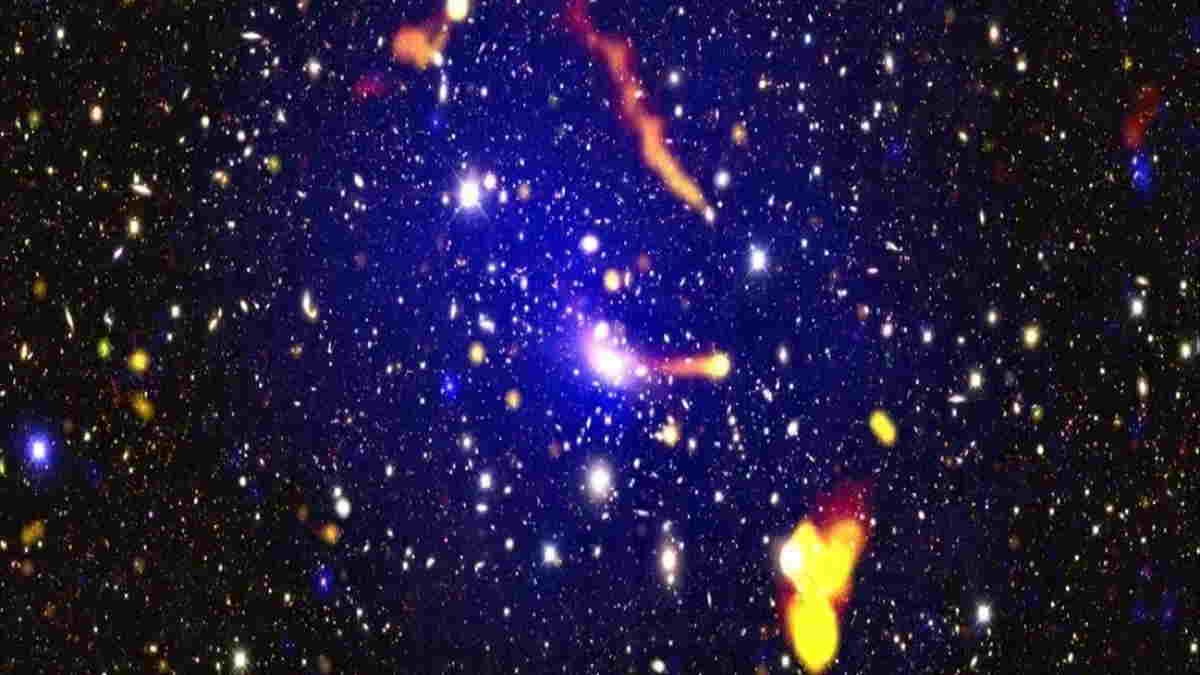The Beri Galaxy Age has long fascinated scientists, astronomers, and space enthusiasts alike. It represents a critical milestone in our understanding of the universe's evolution and the origins of galaxies. This era holds the key to unlocking secrets about the early universe and its development over billions of years. In this article, we will explore the significance of the Beri Galaxy Age and its impact on modern astronomy.
Understanding the Beri Galaxy Age requires delving into the complexities of cosmic history. This period marks the transition from the early universe's simplicity to the formation of the first galaxies. By studying this era, scientists can piece together the puzzle of how stars, galaxies, and ultimately life itself came into existence. The insights gained from this research are invaluable for advancing our knowledge of the cosmos.
This article aims to provide a detailed and accessible overview of the Beri Galaxy Age, covering its origins, key characteristics, and implications for future scientific exploration. Whether you're a seasoned astronomer or a curious space enthusiast, this guide will equip you with the knowledge to appreciate the wonders of this fascinating period in cosmic history.
Read also:Abbie Hern Rising Star In The World Of Entertainment
Table of Contents
- Introduction to Beri Galaxy Age
- The Formation of Galaxies in Beri Age
- Cosmic Timeline and Beri Galaxy Age
- Key Characteristics of Beri Galaxy Age
- Technological Advancements in Studying Beri Age
- Scientific Discoveries Related to Beri Galaxy Age
- Sub-Ages Within Beri Galaxy Age
- Impact of Beri Galaxy Age on Modern Astronomy
- Future Research Directions for Beri Galaxy Age
- Conclusion
Introduction to Beri Galaxy Age
The Beri Galaxy Age is a pivotal period in the universe's history, occurring approximately 13.8 billion years ago. This era is marked by the formation of the first galaxies, which emerged from the primordial gas and dust left over from the Big Bang. Understanding this period requires examining the conditions that led to galaxy formation and the processes that shaped these early cosmic structures.
Scientists have made significant strides in studying the Beri Galaxy Age through advanced telescopes and space missions. These tools have allowed researchers to observe distant galaxies and gather data about their composition, structure, and evolution. By analyzing this information, astronomers can piece together the history of the universe and gain insights into its future trajectory.
The Formation of Galaxies in Beri Age
Initial Conditions for Galaxy Formation
During the Beri Galaxy Age, the universe was in a state of rapid expansion and cooling. This environment provided the perfect conditions for the formation of galaxies. As the universe expanded, matter began to clump together under the influence of gravity, forming dense regions known as protogalaxies.
- Protogalaxies eventually evolved into fully formed galaxies.
- The process of galaxy formation involved the accumulation of gas, dust, and dark matter.
- Stars began to form within these protogalaxies, contributing to their growth and development.
Role of Dark Matter in Galaxy Formation
Dark matter played a crucial role in the formation of galaxies during the Beri Galaxy Age. This mysterious substance, which makes up approximately 27% of the universe, provided the gravitational scaffolding necessary for galaxies to take shape. By studying the distribution of dark matter, scientists can better understand the processes that led to galaxy formation and evolution.
Cosmic Timeline and Beri Galaxy Age
The Beri Galaxy Age fits into a broader cosmic timeline that spans billions of years. This timeline begins with the Big Bang and includes key milestones such as the formation of the first stars, the development of galaxies, and the emergence of life on Earth. Understanding the Beri Galaxy Age's place within this timeline is essential for grasping its significance in cosmic history.
According to NASA and other scientific organizations, the Beri Galaxy Age occurred approximately 100 million to 1 billion years after the Big Bang. During this time, the universe underwent rapid changes, leading to the formation of the first galaxies and the establishment of the cosmic structures we observe today.
Read also:Tylan Bailey Rising Star In The Music Industry
Key Characteristics of Beri Galaxy Age
Early Galaxy Structure
Galaxies formed during the Beri Galaxy Age exhibited unique characteristics compared to modern galaxies. These early structures were smaller, less organized, and contained fewer stars. Over time, these galaxies merged and evolved, giving rise to the diverse range of galaxies we see today.
Star Formation Rates
Star formation rates during the Beri Galaxy Age were significantly higher than in modern galaxies. This period of intense star formation, known as the cosmic dawn, played a critical role in shaping the universe's early development. By studying star formation rates, scientists can gain insights into the conditions that existed during the Beri Galaxy Age and their impact on galaxy evolution.
Technological Advancements in Studying Beri Age
Advancements in technology have revolutionized the study of the Beri Galaxy Age. Modern telescopes, such as the Hubble Space Telescope and the upcoming James Webb Space Telescope, have enabled scientists to observe distant galaxies and gather data about their properties. These tools have provided unprecedented insights into the early universe and its evolution.
In addition to telescopes, computer simulations and modeling techniques have enhanced our understanding of the Beri Galaxy Age. By simulating the conditions that existed during this period, scientists can test theories and make predictions about galaxy formation and evolution.
Scientific Discoveries Related to Beri Galaxy Age
Discovery of the First Galaxies
One of the most significant discoveries related to the Beri Galaxy Age is the identification of the first galaxies. These ancient structures, observed through advanced telescopes, provide valuable information about the early universe and its development. By studying these galaxies, scientists can better understand the processes that led to their formation and evolution.
Insights into Dark Energy and Dark Matter
Research into the Beri Galaxy Age has also shed light on the mysteries of dark energy and dark matter. These enigmatic substances play critical roles in the universe's structure and evolution, and understanding their properties is essential for advancing our knowledge of the cosmos.
Sub-Ages Within Beri Galaxy Age
Reionization Epoch
The Reionization Epoch is a sub-age within the Beri Galaxy Age that marks the transition from a neutral universe to one filled with ionized gas. This period occurred approximately 300 million to 1 billion years after the Big Bang and played a crucial role in shaping the universe's early development.
Starburst Galaxies
Starburst galaxies are another notable feature of the Beri Galaxy Age. These galaxies undergo intense periods of star formation, contributing to their growth and evolution. By studying starburst galaxies, scientists can gain insights into the processes that drove galaxy formation during this period.
Impact of Beri Galaxy Age on Modern Astronomy
The Beri Galaxy Age has had a profound impact on modern astronomy, influencing the development of theories and guiding research directions. By studying this period, scientists have gained valuable insights into the universe's origins and evolution. These discoveries have led to advancements in technology, improved observational techniques, and a deeper understanding of the cosmos.
As research into the Beri Galaxy Age continues, astronomers anticipate making groundbreaking discoveries that will further our understanding of the universe. These findings will undoubtedly shape the future of astronomy and inspire new generations of scientists to explore the mysteries of the cosmos.
Future Research Directions for Beri Galaxy Age
Future research into the Beri Galaxy Age will focus on several key areas, including the development of new telescopes and observational techniques, the refinement of theoretical models, and the exploration of uncharted regions of the universe. These efforts will provide valuable insights into the early universe and its evolution, advancing our knowledge of the cosmos.
Collaboration between scientists, institutions, and nations will be essential for achieving these goals. By working together, researchers can maximize resources, share data, and accelerate the pace of discovery. The results of these efforts will undoubtedly lead to groundbreaking discoveries that will transform our understanding of the universe.
Conclusion
The Beri Galaxy Age represents a critical period in the universe's history, marked by the formation of the first galaxies and the establishment of cosmic structures. By studying this era, scientists can gain valuable insights into the universe's origins, evolution, and future trajectory. The advancements in technology and research methodologies have enabled astronomers to make significant strides in understanding this fascinating period, and future discoveries promise to further our knowledge of the cosmos.
We invite you to share your thoughts and questions about the Beri Galaxy Age in the comments section below. Your feedback is invaluable for fostering discussions and promoting scientific curiosity. Additionally, we encourage you to explore other articles on our site to deepen your understanding of astronomy and the wonders of the universe.


